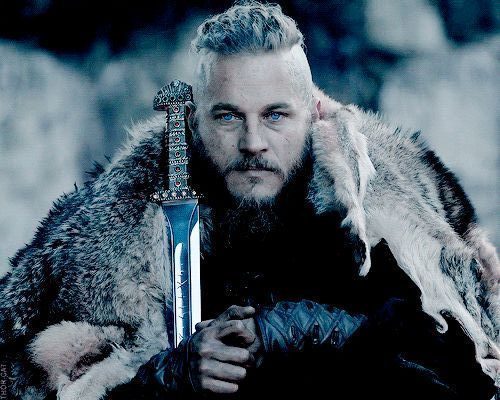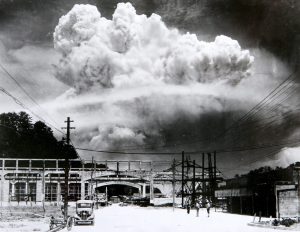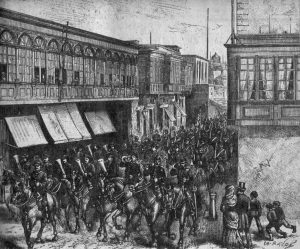For three hundred years, beginning in the ninth century, they sailed the known world and discovered lands beyond their maps.1 They pillaged the peoples of England and France, canals along Middle Eastern coasts, and even their own Scandinavia, venturing as far as the east coast of North America. Being given names, such as pirates, barbarians, monsters, and farmers, today we know them as Vikings. Their people did not fear death in combat, and they would go to great lengths to find a worthy way to die. Being killed heroically with a weapon in hand could get the attention of a Valkyrie, or angelic female warrior, to determine if ones death was worthy. If deemed worthy one would ascend to Valhalla, the Nordic afterlife for a warrior, where one would brag about one’s adventures and fight to the death daily in the army of Oden, chieftain of the Norse gods, as preparation for the end of the world. One man that stood out among these hardened people and became one of the first Scandinavian kings was Ragnar Lothbrok.2
Being born just before the turn of the year 800 CE, Ragnar Lothbrok brought together the Scandinavian war bands under his command. With Europe poorly protected, and with Charlemagne’s rule coming to an end, Ragnar took the advantage and led his Vikings on many campaigns to loot Europe of its treasures.3 With little real knowledge of the Norsemen, the peoplesand treasures of Europe were easy targets. When in the fighting line, Ragnar was said to dwarf his companions that stood around him and fought in his armies as a berserker.4 A berserker is a warrior that fights in a rage-filled trance, being able to take on multiple injuries before falling in battle. Ragnar was admired for his skills in battle and for his strategic mind. His armies could hold their own against Charlemagne’s forces due to his strategic cunning. Ragnar is even father to other well-known Viking warriors, Bijorn Ironside, Hubb, and Ivar the Boneless, a figure of terror in Irish and English storytelling.5

The untimely demise of Ragnar Lothbrok became a story of revenge. With so many battles and victories against the Anglo Saxons, Ragnar had created enemy in Aelle, ruler of York. During Ragnar’s last battle, he was captured by the Anglo Saxons and became a prisoner. In honor of his new prisoner, Aelle, ruler of York, ordered his men to build a pit of snakes for Ragnar to be thrown into. As the snake venom was running through Ragnar’s veins, he is reported to have uttered, as his last words, “How the little pigs will grunt when they hear how the old boar has died,” referring to his sons as the avengers of his death.6 The death of Ragnar Lothbrok supposedly triggered a new age of Viking attacks. Those attacks had the ferocity and intensity that Vikings later became known for. Seeking to avenge their father’s death, Ivar the Boneless and his two brothers led their Viking forces to East Anglia in 865 CE. In the name of revenge, the brothers captured Aelle and killed him with the rite of the blood eagle.7 This rite was a gruesome and painful form of execution by torture that resulted in a slow death; after the torture, the poor soul subjected to the rite was to be tied by the wrists in the air to two separate trees, to resemble a bird in flight, to honor Oden’s sacred bird, the eagle. The ritual was so gruesome that it was hardly ever used and only on those deserving of it.

The story of Ragnar Lothbrok became a legend and was written into the Icelandic sagas and the Gesta Danorum.8 Over time he became another epic hero in a story with impossible adventures. Between the seventh and ninth centuries, multiple stories and lives of other people named Ragnar have surfaced. Despite these multiple stories, there will only be a true original Ragnar Lothbrok, the one that forced his way into history and built the reputation of the Vikings.
- Gale Encyclopedia of World History, 2008, s.v. “Viking Raids and Norman Conquests (8th to 11th Centuries).” ↵
- P.D. Kirby, “Review of A.P. Smyth’s Scandinavian Kings in the British Isles 850-880,” The English Historical Review 94, no. 370 (January 1979): 162-163. ↵
- P.D. Kirby, “Review of A.P. Smyth’s Scandinavian Kings in the British Isles 850-880,” The English Historical Review 94, no. 370 (January 1979): 162-163. ↵
- Gale Encyclopedia of World History, 2008, s.v. “Viking Raids and Norman Conquests (8th to 11th Centuries).” ↵
- Encyclopedia of the Barbarian World, 2004, s.v. “Bronze Age to Early Middle Ages,” by Peter Bogucki and Pam J. Crabtree. ↵
- Encyclopedia of the Barbarian World, 2004, s.v. “Bronze Age to Early Middle Ages,” by Peter Bogucki and Pam J. Crabtree. ↵
- Roberta Frank, “Viking Atrocity and Skaldic Verse: The Rite of the Blood Eagle.” The English Historical Review 99, no. 391 (April 1984):332-343. ↵
- Neil Schlager and Josh Lauer, Science and Its Times (Detroit: Gale, 2001), 100-101. ↵



50 comments
Abigale Carney
Very interesting article! I have actually seen the show Vikings before! Ragnar Lothbrok was great and gruesome in battle, and the story of the Vikings is very interesting. The show has given me background information on Vikings, but after reading this I feel as if it bettered my understanding of the Vikings and how they lived. This article was very well written, and I really enjoyed your topic!
Evelin Joseph
This article was definitely engaging and truly made me want to learn more about Ragnar Lothbrok. It is a shame that I have never before heard of such a Viking and his epic story. He seemed to be a dedicated warrior that possessed great skill and extreme stamina. It was truly sad to hear about his demise, but it was nice to hear that he was avenged and died bravely. To be thrown into a pit of venomous snakes seems atrocious, but he was able to get revenge through his sons. It’s amazing that these revenge battles eventually became what the Vikings were known for and that the legend still continues to be influential and powerful to this day.
Auroara-Juhl Nikkels
Vikings is one of my favorite TV shows and most of the information in this article is covered in the show. The article was very well written and I stayed engaged the whole time. I feel like many people forget about some of the great figures in history that are almost key in the world’s history. Norse history is another history that interest me because it’s not completely similar to Greek, Roman, or Egyptian. Norse mythology has Valhalla and that is different than the other mythologies.
Valeria Hernandez
Mark Martinez does a great job at telling the story of Ragnar Lothbrok. I truly enjoyed how to the author told a story incorporating a climax, falling action, protagonist, and antagonist. He assembles a perfect story regarding a villain Viking man that was captured and killed in a brutal way due to his history of violence. The article captures readers attention because of Martinez creation of a rising action.
Matthew Rios
The Norse epics in my opinion tell some of the greatest tales of all time. From Thor to Valhalla, the Vikings really take the cake. It was nice to see an article on them for a change, I feel like we tend to forget about them and their prominence in history at times. Luckily we have yet to forget Ragnar Lothbrok.
Briana Myers
I had heard about the Vikings before this article, but I had never heard of Ragnar Lothbrok. It is very interesting how he was a very brave warrior that was strong and very skilled in battle. The way he used his aggressiveness to keep himself alive is interesting. It is unfortunate that he had died in such a terrible manner; however he was avenged by his sons which really shows hoe loyal they were to his father.
Brianda Gomez
I really enjoyed reading this article. The featured image really called my attention. I have never really heard a lot about Vikings. It was informative by showing us the background of this legend: Ragna Lothbrok. How he built a reputation of the Viking is crazy and how these men would die. The way that Ragna died, shocked me the most. I cannot imagine being in a pit of snakes.
Deanna Lummus
I found this most compelling. I have never thought much about Vikings but this gave me chills. I never knew how committed they were to being honored in the afterlife and how this mentality paved the path they took in life. I didn’t know just how keen they were on fighting. I knew they were ruthless and powerful but now how much they enjoyed it. To die in battle is to die being a very honorable person, this takes on new meaning to me now. I also loved hearing how the whole Vikings movement got started with a new wave of committed Vikings looking to Ragnar Lothbrok’s story as true and something to be idolized.
Ryann Cervantes
I not only liked the article but the character of Ragnar. He sounds like the pinnacle and ideal image of a true Viking or berserker. Even how on his deathbed he did not fear his death but only commented on how his sons would miss him. And although you didn’t describe the execution method much in detail, it actually helps because it leaves the reader to imagine just how bad the torture method was.
Alexis Soto
The image caught my attention right away. I am a big fan of the show “Vikings” so I was glad someone decided to write about it. Much of what I read from this article was covered in the show, so I was familiar with Ragnar and his story. The Vikings are an interesting group of people with a rich culture. Ragnar was one of many characters that have left an imprint in history.